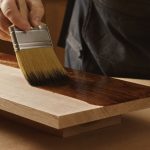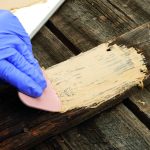How To Clean Antique Furniture Without Stripping: 3 Gentle Techniques
The condition of your antique furniture plays a significant role in determining its value and desirability. However, cleaning antique furniture can sometimes have unintended consequences, like stripping the finish. Thankfully, several safe cleaning methods can help preserve antique furniture while keeping it clean.
So, how to clean antique furniture without stripping it? There are ways to clean your antique furniture based on the conditions, such as
- For grime and dirt, use an oil soap solution. An alternative to the oil soap solution is mineral spirit
- For cleaning mildew, use a mixture of vinegar and linseed oil
- To clean and polish in the same session, use a polish reviver
Let’s dive deeper into how to clean and restore antique furniture. We’ll take you every step of the way and even uncover cleaning products to steer clear of.
How To Clean Antique Furniture Without Stripping: Antique Furniture Restoration Techniques
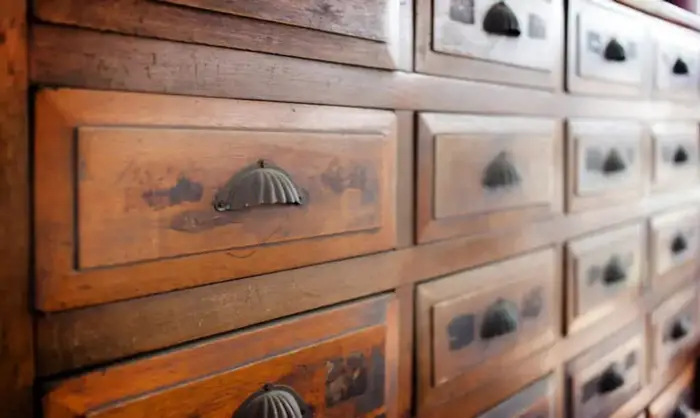
Proper cleaning can preserve and bring out the patina even more, making furniture look better and more valuable. This table highlights the type of cleaning you need for your antique furniture and the best technique to use.
| Type of Cleaning | Best Technique To Use |
|---|---|
| Dirt and grime removal | Oil soap solution or mineral spirit |
| Mildew removal | Vinegar and oil mixture |
| Cleaning and polishing | Polish reviver (vinegar, turpentine, linseed, methylated spirit mixture) |
Note that these methods are only for clear antique finishes like shellac, varnish, and lacquer. Avoid cleaning painted or unfinished antique furniture – only dust them.
How To Clean Grime and Dirt In Antique Furniture
As you can see from our table, you have two options. Depending on what you have available, you can choose to clean it with mineral spirit or oil soap solution.
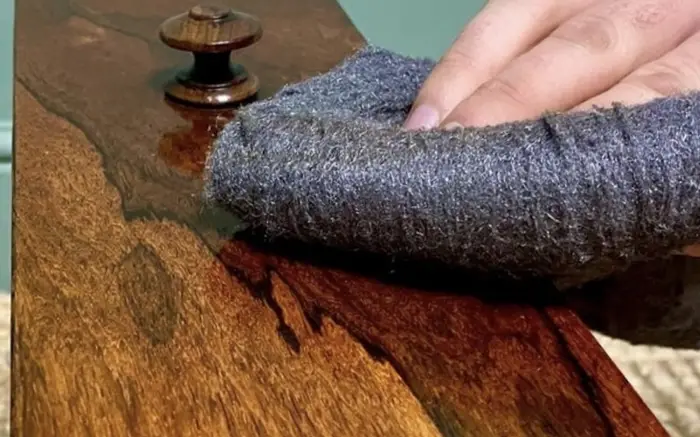
Using Oil Soap Solution To Clean and Restore Wood Furniture
To keep your antique furniture looking fresh without wrecking the finish, try using an oil soap solution. Before then, here’s what you do:
What You Need
- Soft cloth that doesn’t leave fibers behind
- A bowl or a bucket
- Mild dish soap
- Warm water
- Commercial oil soap like Murphy Oil Soap
Step 1: Make the oil soap mix
Mix warm water with a tiny bit of dish soap in a bowl or bucket. A couple of drops of dish soap in a gallon of water is usually good. Follow the instructions on the oil soap bottle for how much to use.
Step 2: Vacuum or dust the furniture
Before using the oil soap solution, gently vacuum or dust off the antique furniture with a soft cloth to get rid of loose dirt. This keeps you from scratching the finish while cleaning.
Step 3: Test a small spot
To make sure the oil soap won’t mess up the wood or finish, test it on a hidden part of the furniture first. Rub the solution on a small spot, then wait a few minutes. If nothing bad happens, you’re good to clean the whole thing.
Step 4: Clean the furniture
Dip a soft cloth in the oil soap mix and wring it out. Then gently wipe down the antique furniture with the grain of the wood. Be careful not to soak the wood too much – too much moisture can damage the finish.
Step 5: Remove stubborn stains
For tough stains or buildup, use a soft-bristled brush dipped in the solution to scrub that spot. But do it gently- you don’t want to wreck the finish.
Step 6: Wipe off the residue
Once you’re done cleaning, use a separate cloth to wipe off any leftover oil soap on the furniture’s surface. This leaves it looking fresh.
Using Mineral Spirits To Clean and Restore Wooden Furniture
For tougher grime and stuck-on junk, mineral spirits can really come in handy. Follow these steps to use them safely:
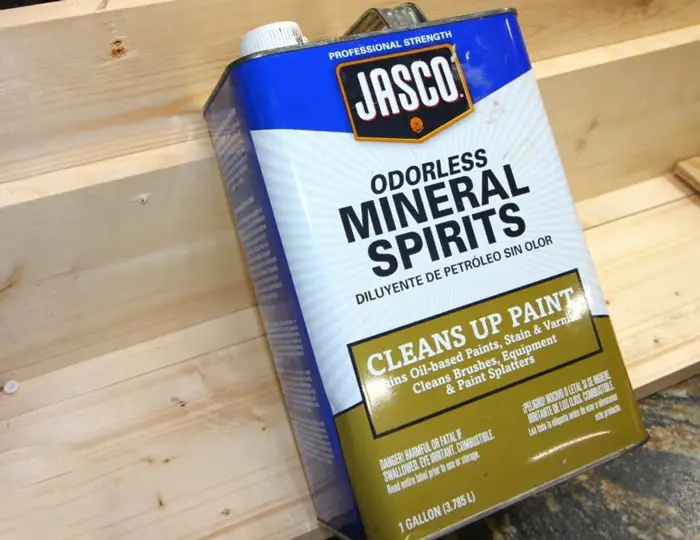
What You Need
- Soft cloth that won’t leave fiber behind
- Methylated spirit (also known as denatured alcohol)
- A bowl or container to put the mineral spirit
Step 1: Ventilation
Before you start, make sure you’re working in a well-ventilated area when using mineral spirits. That way, you won’t be breathing in that smelly stuff.
Step 2: Test a small spot
Just like with the oil soap, test mineral spirits on a hidden part of the furniture to make sure it doesn’t react badly.
Step 3: Apply mineral spirit
Dampen soft cloth in mineral spirit, but not so much that it’s drippy. Gently wipe the areas that need cleaning on the antique furniture, going with the wood grain.
Step 4: Scrub stubborn stuff
Dip a soft-bristled brush in mineral spirit and gently scrub just that spot for tough stains or grime that won’t budge.
Step 5: Wipe away the residue
Once you’re done cleaning, use a separate dry cloth to wipe away any leftover mineral spirit on the surface.
How To Restore Wood Furniture With Vinegar: Mildew Removal
Alright, to get rid of mildew in your wood furniture, mix up some vinegar and oil. Here’s what you do:
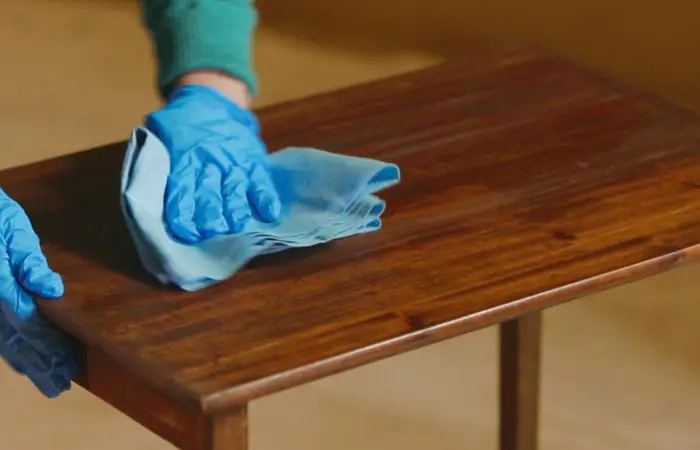
What You Need
- White vinegar
- Boiled linseed oil
- Soft lint-free cotton
- A bowl
Step 1: Create the vinegar and oil mixture
First, mix equal parts vinegar and oil in a bowl. The vinegar takes care of the mildew, while the oil nourishes the wood.
Step 2: Test a small spot
Before going all in, test the mix on a hidden spot to make sure it doesn’t mess up the finish.
Step 3: Apply the mixture
Take cotton and dip it in the mix – don’t let it drip. Gently rub the mildewy areas following the grain. For really stubborn mildew, use a soft bristle toothbrush dipped in the mix and scrub the surface.
Step 4: Wipe off the residue
Once the mildew’s gone, wipe off any leftover mix with clean, dry cotton. Let the furniture air dry completely.
How To Clean Polished Antique Furniture With Polish Reviver
To get that shine back on your old furniture – use Furniture Reviver or polish reviver. It’s simple to apply, cleans off the built-up gunk, and keeps the finish looking good.
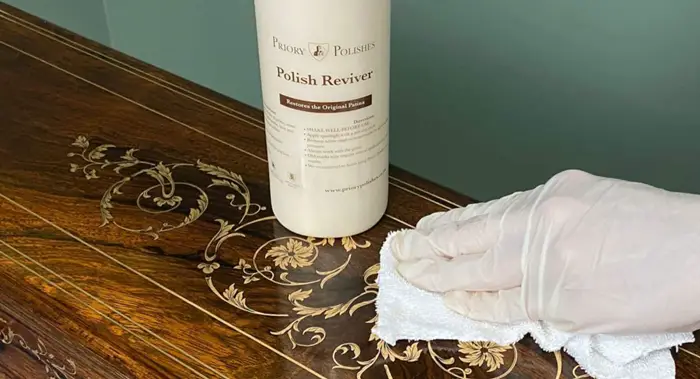
What You Need
- Polish reviver (mix equal parts vinegar, linseed oil, turpentine, and a teaspoon of methylated spirit)
- Soft cloth or cotton pads
- Soft bristle dusting brush
Step 1: Dust the surface
Get rid of any dust. You can use a vacuum and soft bristle brush for the crevices.
Step 2: Apply the reviver
Shake the reviver to mix all the ingredients. Dip a soft cloth in the reviver, wring it, and rub gently in a circular motion. Work on one part at a time so you can spread and rub the reviver evenly.
Step 3: Let it sit
Leave the reviver on for a few minutes to seep and dry out.
Step 4: Wipe off excess and buff the surface
Use a soft, dry cloth to wipe away any leftover reviver. Use a separate, clean cloth to buff the surface using light pressure in circles to make it shine.
Note that polish revivers are safe for whatever kind of polished furniture you have. In addition to removing dirt, it also polishes in the same operation. The drawback is that the residue tends to darken over time. For this reason, we recommend that you use a furniture reviver with moderation.
Products To Avoid For Safe Antique Furniture Cleaning

Before starting any cleaning or polishing, you got to be super careful with store-bought cleaners or polishes. While some products claim to be safe, the long-term effects aren’t always clear.
- In particular, watch out for silicone polishes. Over time, they can leave this gross, whitish film that normal waxing won’t get rid of.
- In addition, silicone products cause splitting and cracking in lacquer finishes.
So, it’s best to skip such products to keep your antiques looking good and worth the most. Instead, stick with the gentler cleaning methods we mentioned earlier. These tried-and-true methods are less likely to mess things up, keeping your antique looking good for generations.
If you’re seeking methods to clean antique furniture without stripping away its character and history, our guide on can you put water-based polyurethane over oil-based polyurethane might also catch your interest. Additionally, if you’re aiming for a flawless finish and want to learn how to apply polyurethane without brush marks, our comprehensive guide on how to apply polyurethane without brush marks could provide you with the techniques and tips you need. We’re committed to helping you maintain the beauty and quality of your furniture projects, and our resources are designed to assist you in achieving the best results.FAQs
Let’s answer common questions related to “How to clean antique furniture without stripping.”
Q. How often should I wax my antique furniture?
Only apply furniture wax to your antique pieces every once in a while – like once a year – to avoid building up too much wax. If the shine starts looking dull between the waxing sessions, give it a good buff with a rag. This should bring back the luster of the finish without adding more wax.
Q. What is the best oil to restore antique furniture?
Use natural drying oils, specifically linseed oil and tung oil. Linseed is an all-purpose oil that brings out the natural color and grain of wood. On the other hand, tung oil provides a durable protective finish with a deep, amber color.
Q. Should antique furniture be oiled?
Furniture oils will make the finish look nice, but only in the short term. Oils leave a residue that dust and dirt stick to. All that gunk breaks down the finish over time.
Conclusion
To sum it up – the methods we talked about are safe ways to clean antique furniture. You’ll have your antique all fresh without messing with the original finish, which helps keep its value.
Note that the cleaning methods we discussed are solely for antique furniture with finishes still in decent shape – not peeling or flaking. If your finish is super damaged or darkened up and really bad, get a professional conservator to restore it properly. The same goes for unfinished antique furniture or one with painted surfaces.



